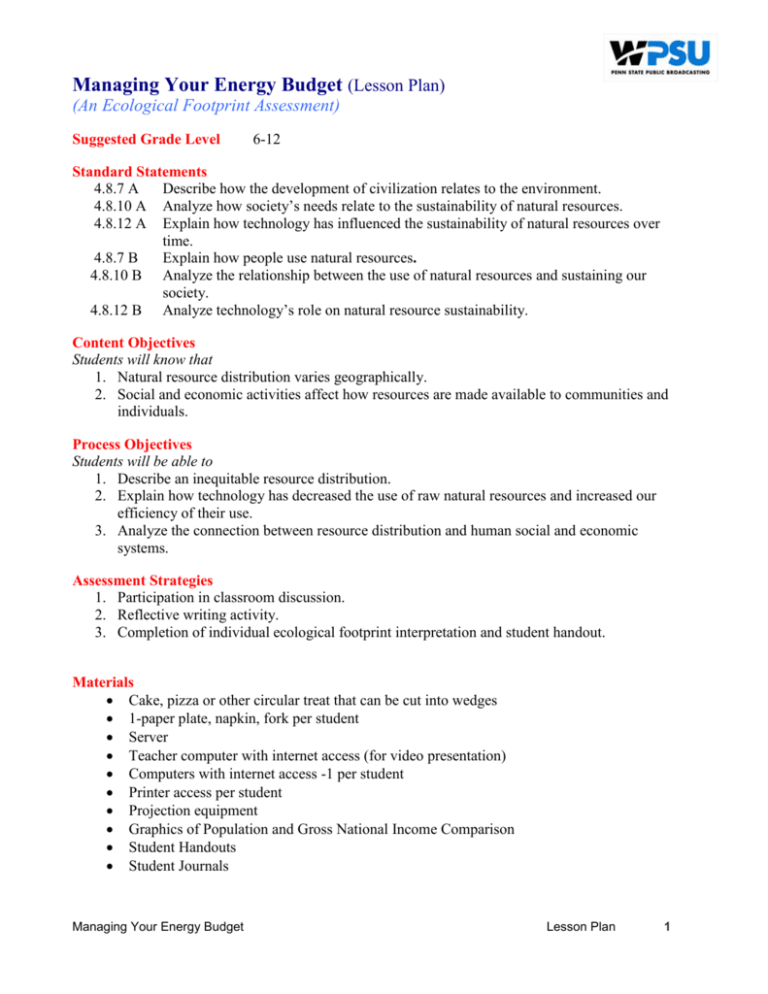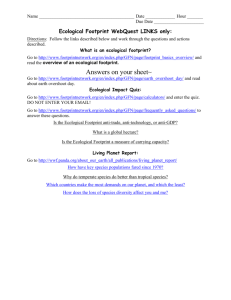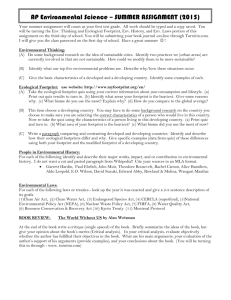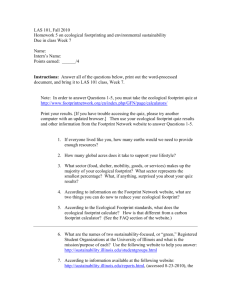Managing Your Energy Budget (Lesson Plan)
advertisement

Managing Your Energy Budget (Lesson Plan) (An Ecological Footprint Assessment) Suggested Grade Level 6-12 Standard Statements 4.8.7 A Describe how the development of civilization relates to the environment. 4.8.10 A Analyze how society’s needs relate to the sustainability of natural resources. 4.8.12 A Explain how technology has influenced the sustainability of natural resources over time. 4.8.7 B Explain how people use natural resources. 4.8.10 B Analyze the relationship between the use of natural resources and sustaining our society. 4.8.12 B Analyze technology’s role on natural resource sustainability. Content Objectives Students will know that 1. Natural resource distribution varies geographically. 2. Social and economic activities affect how resources are made available to communities and individuals. Process Objectives Students will be able to 1. Describe an inequitable resource distribution. 2. Explain how technology has decreased the use of raw natural resources and increased our efficiency of their use. 3. Analyze the connection between resource distribution and human social and economic systems. Assessment Strategies 1. Participation in classroom discussion. 2. Reflective writing activity. 3. Completion of individual ecological footprint interpretation and student handout. Materials Cake, pizza or other circular treat that can be cut into wedges 1-paper plate, napkin, fork per student Server Teacher computer with internet access (for video presentation) Computers with internet access -1 per student Printer access per student Projection equipment Graphics of Population and Gross National Income Comparison Student Handouts Student Journals Managing Your Energy Budget Lesson Plan 1 Multimedia Resources Part 2 PSU Center for Sustainability website: http://www.engr.psu.edu/cfs/ Center for Sustainability Video Segments 1 (Welcome) and 2 (Ecological Footprint) Part 3 Redefining Progress Ecological Footprint Calculator: http://www.myfootprint.org/ Major Trends website: http://www.footprintnetwork.org/gfn_sub.php?content=footprint_acres Part 4 Center for Sustainability Video Segments 3-7 (3-Inside Yurt, 4-Kitchen Tips, 5-Bathroom Details, 6-Greenhouse, 7-Bike Power) Procedures Part 1: Eating Cake1 (1, 50-min Class Period) 1. Prior to the lesson day, make or purchase a cake, pizza, etc. to share with your class. 2. Show the cake to the class and explain that you have brought it to share with them and learn more about natural resources. 3. Ask the students if the classroom next door should be invited to join then in eating the cake. If the students say no, ask them why not. Explain that this represents the concept of environmental scarcity, where there is not enough of a resource for everyone who wants or needs it. (If the class from next door came over, there would be less resource per person.) 4. Explain that you will not invite the class from next door; you will divide the cake for the class to share. Ask them to imagine that they represent all the people on the earth. Share the pie graphs found in the Teacher Notes comparing the distribution of population (the graphic has two pie graphs--cover the second one focusing on GNI (Gross National Income) so that you can build the discussion about the first pie graph.) 5. Separate the class into groups as shown in the table below: For a class of 30: For a class of 20: Representing % of Earth’s Population 4 3 Africa 13% 2 1 US & Canada 5% 3 2 Latin America 9% 4 2 Europe 12% 17 12 Asia 61% 6. Ask each region how they feel about this distribution. Explain to students that the cake is going to be distributed as resources are actually divided up in the world, based upon per capita GNI. Share the second pie graph at this point. Cut the cake into proportions indicated by the second pie graph. Put the pieces of cake on separate plates and distribute to each region. 7. Ask each region how they feel about their share of the cake. Ask each region what they are going to do about the situation. Will they migrate to the US & Canada to share in their cake? Facing the Future.org “Let Them Eat Cake.” http://facingthefuture.org/Members/teach/pdf/handson/eat-cake.pdf, accessed 15 January 2006. 1 Managing Your Energy Budget Lesson Plan 2 Allow students to work through this issue (some discrimination may not be a bad point to allow students to make). 8. To end this class period, some sample prompts are listed below to assist students in completing a reflective free-write about their experience. Have them use the student handout to complete their reflection. How does this game relate to the real world? How would this have been different if you had not eaten much or anything in a few days? What are some real examples of people trying to get more cake? What are some ways that you can address the inequitable distribution of resources? Part 2: What is Your Ecological Footprint? (1, 50-min Class Period) 1. Introduce Penn State University’s Center for Sustainability (http://www.engr.psu.edu/cfs/) and share video segments 1 (Welcome) and 2 (Ecological Footprint) to introduce the concept of ecological footprint. 2. Share the ecological footprint calculator with students and discuss ways in which nondriving students can complete the questions about travel and transportation. Clarify any unfamiliar terms by walking through the survey with the entire class. Allow students to access and complete the ecological footprint calculator at: http://www.myfootprint.org/ and print their personal report. 3. Share the following website with students and highlight the major trends: http://www.footprintnetwork.org/gfn_sub.php?content=footprint_acres. It is helpful to exemplify the term acre. A helpful comparison is that an acre is roughly the same size as a football field. 4. Describe homework activity (Part 3) and model ways that one may reduce their ecological footprint. Part 3: Take It Home to Think (Homework Assignment) 1. Students should use page 2 of the student handout to prepare a short analysis of the results of their ecological footprint report for homework. Additionally, ask students to brainstorm and record any ways that they may personally be able to reduce their impact on resource use. Part 4: (40 minutes) 1. Share the Center for Sustainability video segments 3-7 to share an example of how one person is working to reduce his ecological footprint. Video 3 – Inside Yurt Video 4 – Kitchen Tips Video 5 – Bathroom Details Video 6 – Greenhouse Video 7 – Bike Power 2. Challenge students to propose ways that they would be comfortable altering their lifestyle to reduce their impact. Give them an opportunity to revisit their brainstorming from the previous class to modify it if necessary. Remind students that not everyone would see the way of living proposed in the video as acceptable and that geographic constraints will dictate what options are even available as alternatives. Managing Your Energy Budget Lesson Plan 3 3. Allow students to formulate and record their ideas on separate sheets of paper and then prompt them to share their ideas with a partner or small group. 4. Lead a class discussion to highlight students’ strategies for reducing their ecological footprint. Extensions 1. Undertake an action project with students to identify the ecological footprint of the school or community. Links to “calculators” (metrics) developed by the Environmental Protection Authority of Victoria, Australia, are included in the Additional Resources section. 2. Mathematics connection: Analyze the metrics used by the organization Redefining Progress in calculating ecological footprint. Managing Your Energy Budget Lesson Plan 4 Managing Your Energy Budget (Teacher Notes) (An Ecological Footprint Assessment) Part 1 Notes Gross National Income. GNI was previously known as Gross National Product. Gross National Income comprises the total value of goods and services produced within a country (i.e. its Gross Domestic Product), together with its income received from other countries (notably interest and dividends), less similar payments made to other countries. The values represented in the pie graphs are adjusted for purchasing power parity (PPP), an estimate of the exchange rate required to equalize the purchasing power of different currencies, given the prices of goods and services in the countries concerned. Part 2 Notes When students access the ecological footprint calculator, they will first need to select their country and language. Students will then move onto the page shown below. You may decide it best to advise that they skip the optional sections requesting zip code and email address. The entire quiz is sixteen (16) questions long and asks several questions about community size, square footage of their home, and transportation patterns. This section may be better used as a homework assignment if students are not familiar with consumption patterns of their family. Managing Your Energy Budget Teacher Notes 1 The results page is a resource for students to brainstorm ideas about how they may make changes to their consumption patterns to reduce their footprint. There are also links for additional information about the quiz and ideas for further action on the right hand side. Examples of Student Action Ideas. A wide array of examples of ways that students can address the inequitable distributions of resources include: reduce, reuse and recycle resources; buy energy-efficient and sustainably designed products; volunteer at nonprofit organizations work towards social justice; and talk about this issue with friends and family. Additional References Penn State University’s Center for Sustainability http://www.engr.psu.edu/cfs/ Facing the Future http://www.facingthefuture.org/# Redefining Progress Homepage http://www.redefiningprogress.org/footprint/ Global Footprint Network http://www.footprintnetwork.org/gfn_sub.php?content=footprint_overview School Ecological Footprint Calculator from EPA-Victoria (excel file and PDF) http://www.epa.vic.gov.au/Eco-footprint/Schools/default.asp Notes on Materials Video Resources. Depending upon the availability of computers for your instruction, the Center for Sustainability video resources may be viewed by students in small groups, directly from the internet instead of in a large group setting. Managing Your Energy Budget Teacher Notes 2 Managing Your Energy Budget Population and GNI Comparison Managing Your Energy Budget Global Issues as defined by Facing the Future. Name:________________________ Managing Your Energy Budget (Student Handout) (An Ecological Footprint Assessment) Part 1 (Reflection) Record your response to the activity done in today’s class. If your teacher has provided you with a reflection question, use it to guide your thinking. Record any ideas you may have for making our resource distribution more equal. __________________________________________________________________________ __________________________________________________________________________ __________________________________________________________________________ __________________________________________________________________________ __________________________________________________________________________ __________________________________________________________________________ __________________________________________________________________________ __________________________________________________________________________ __________________________________________________________________________ __________________________________________________________________________ __________________________________________________________________________ __________________________________________________________________________ __________________________________________________________________________ __________________________________________________________________________ __________________________________________________________________________ __________________________________________________________________________ __________________________________________________________________________ __________________________________________________________________________ __________________________________________________________________________ __________________________________________________________________________ __________________________________________________________________________ __________________________________________________________________________ __________________________________________________________________________ Managing Your Energy Budget Student Handout 1 Parts 2 and 3 (Calculating and Analyzing Your Ecological Footprint) Now that you have calculated and printed your Ecological Footprint, answer the following questions using data from your results and class discussions. Please attach a copy of your Ecological Footprint results to the back of your handout. 1) How does your ecological footprint compare to the average for the United States? The equal Earth share? 2) Using your “Quiz” results, in which area(s) could you make the greatest change to reduce your footprint? Please explain your choice and what you could do to make that change. (Be realistic about what would make sense for you personally.) 3) After watching the videos of Penn State University’s Center for Sustainability, what if any additional strategies could you use to make your natural resource use more equal when thinking about the rest of the world? Managing Your Energy Budget Student Handout 2





